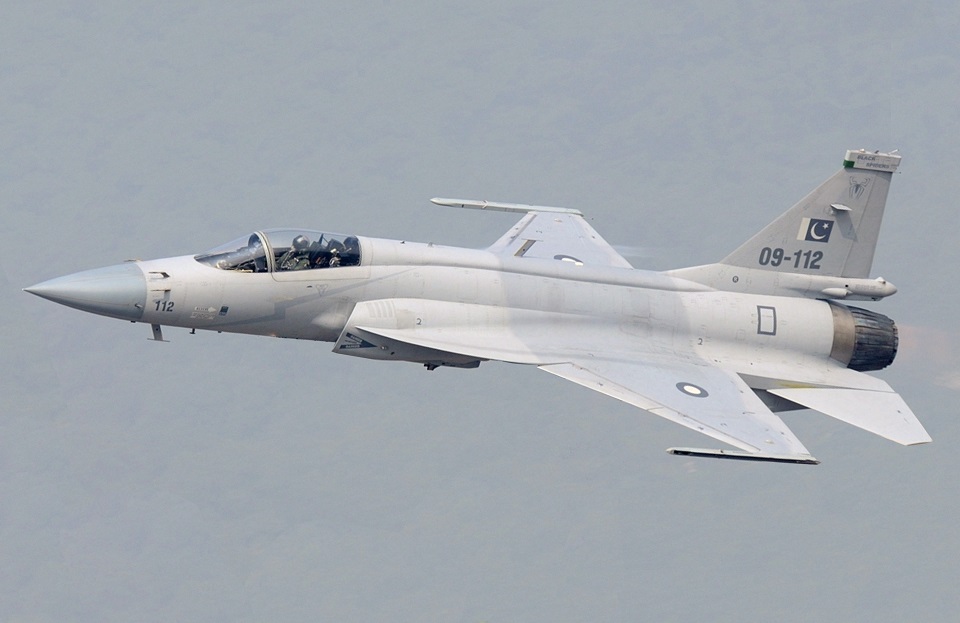Defence
PAF Opts for Chinese WS-13IPE Engine Over Russian RD-93MA for JF-17 Upgrade

In a strategic shift, the Pakistan Air Force (PAF) has decided to deviate from its initial plan of upgrading the JF-17 Thunder fighter jets with the Russian RD-93MA engine. Instead, the PAF has chosen the Chinese WS-13IPE engine, signaling a significant move in the realm of engine procurement for its jointly developed aircraft with China.
Russian Klimov RD-93 turbofan engine
The JF-17 Thunder, a collaborative effort between Pakistan and China, has been relying on the Russian Klimov RD-93 turbofan engine. Seeking to enhance the aircraft’s capabilities, the PAF initially considered the RD-93MA upgrade, which promised a substantial increase in thrust compared to its predecessor.
However, the challenges of securing spare parts and maintenance support from Russia prompted a re-evaluation of the PAF’s engine upgrade strategy.
Stepping into this scenario, Guizhou Liyang Aero Engine Co., Ltd. presented the WS-13 as a powerful, domestically produced alternative. While the baseline variant offered only a modest increase in thrust over the RD-93, its mass production, which commenced in 2021, and the readily available support infrastructure played pivotal roles in swaying the PAF’s decision.
Engine RD-93MA’s 91.7 kN Thrust
The WS-13, developed by Guizhou Liyang Aero Engine Co., Ltd., boasts a thrust of 86 kilonewtons, a marginal improvement over the RD-93’s 81.3 kN.
It is worth noting that this falls short of the RD-93MA’s 91.7 kN thrust, potentially leaving some room for improvement. However, the decision to opt for the WS-13 was likely influenced by the challenges faced in obtaining support from Russia, as well as the assurance of a steady supply chain from the Chinese side.
One noteworthy aspect is China’s ongoing development of a more powerful 93kN engine for its FC-31 fighter jets. This introduces an interesting dynamic, as the PAF might end up operating the FC-31 due to relaxed payment terms and discounts offered by China to Pakistan.
The WS-13IPE’s selection might be seen as a pragmatic choice, balancing immediate needs with future considerations.
Exploring the intricacies of its technological prowess, the JF-17 integrates a sophisticated three-axis digital fly-by-wire flight control system, an infrared search, and track (IRST) system, and a collaborative effort in the form of a helmet-mounted display and sight (HMD/S) system jointly manufactured by Pakistan and China.
A remarkable feature is the presence of a larger yet thinner holographic wide-angle heads-up display (HUD), providing enhanced visibility and situational awareness. Complementing this, an upgraded electronic warfare management system further solidifies the JF-17 capabilities.

Defence
Russia’s NV.17 Hybrid Helicopter Aims to Balance Light and Heavy Helicopter Needs

As Western sanctions continue to impact Russia’s aviation sector, the country is making significant strides in advancing its domestic aerospace capabilities.
Despite the ongoing challenges, Russia has unveiled the Heliburo HB.17, a cutting-edge hybrid-powered medium-class helicopter that promises to reshape both commercial and military aviation.
The helicopter is currently in the technical design phase, with plans for its first flight slated for 2027. This marks a major step forward in Russia’s efforts to modernize its aviation fleet and reduce reliance on foreign technology.
This country tops visa rejections in the popular Schengen countries
The HB.17 is designed as a versatile, multi-role aircraft, capable of performing a wide range of functions. It is built to handle cargo transport, passenger carriage, reconnaissance, and close air support missions. With its robust design and flexible capabilities, the HB.17 is expected to meet the needs of both military and commercial operators, offering a solution for missions requiring a greater capacity than light helicopters but avoiding the limitations of larger aircraft.
One of the most innovative features of the HB.17 is its hybrid power plant. This combination of conventional and electric technologies enhances fuel efficiency, allowing the helicopter to stay airborne for up to seven hours without needing to refuel.
This extended operational endurance makes the HB.17 particularly well-suited for long-duration missions, providing a significant advantage over traditional helicopters. Additionally, the HB.17 will be equipped with modern avionics, ensuring advanced navigation, communication, and operational capabilities.
Qatar Airways Cargo and MASkargo Launch New Strategic Partnership
The HB.17 is positioned to compete with other medium-class helicopters such as the Kamov Ka-60/62 and the Mil Mi-38. However, its hybrid powerplant and modern avionics set it apart, offering a more efficient and technologically advanced alternative.
Its multi-role versatility, combined with its fuel efficiency and cutting-edge systems, gives it a competitive edge in the evolving aviation landscape. The introduction of the HB.17 follows recent reports of Russia receiving a new batch of armored vehicles from the UAE-based Streit Group.
Russia has traditionally focused on producing helicopters for defense purposes, but this time, it appears to be venturing into the civilian helicopter market with the HB.17.
This, along with the ongoing development of the HB.17, reflects Russia’s continued efforts to modernize its military assets and increase its self-reliance, even as sanctions continue to pressure its defense and aerospace sectors.
As Russia faces mounting geopolitical challenges, the HB.17 stands as a symbol of resilience, technological innovation, and determination to maintain its military and aviation capabilities.
-

 Aviation2 months ago
Aviation2 months agoMicrosoft Flight Simulator Raises $3 Million to Bring Back the An-225 Mriya
-

 Airlines2 months ago
Airlines2 months agoQatar Citizens Can Travel to the United States Without a Visa
-

 Aviation2 months ago
Aviation2 months agoQatar Airways bans these new Electronic Devices on plane
-

 Airlines2 months ago
Airlines2 months agoJapan Airlines Rolls Out Free Domestic Flights to International Passengers
-

 Defence2 months ago
Defence2 months agoWhich Country Has the Largest Fleet of Fighter Aircraft?
-

 Airport2 months ago
Airport2 months agoWestern Sydney Airport Welcomes Its First Plane After 6 Years of construction
-

 Travel2 months ago
Travel2 months agoQatar Airways Launches Four Additional Flights from Amsterdam
-

 Aviation2 months ago
Aviation2 months agoDid you know ? Once Boeing 747 carried 1088 passenger in 1991








